Intel’s Sandy Bridge i7-2820QM: Upheaval in the Mobile Landscape
by Jarred Walton on January 3, 2011 12:00 AM EST- Posted in
- Laptops
- Intel
- Sandy Bridge
- Compal
Mobile Sandy Bridge Gaming Performance
Sandy Bridge is clearly a faster CPU than the preceding Arrandale and Clarksfield offerings—that’s no surprise. The integrated graphics are also faster, but being faster than old Intel’s HD Graphics isn’t saying a whole lot. Then again, AMD’s old HD 4250 IGP isn’t much better and is long overdue for a replacement. We’ll talk about that in a second, but first here are the standard gaming performance results at our “Low” defaults. “Medium” detail will be on the next page.
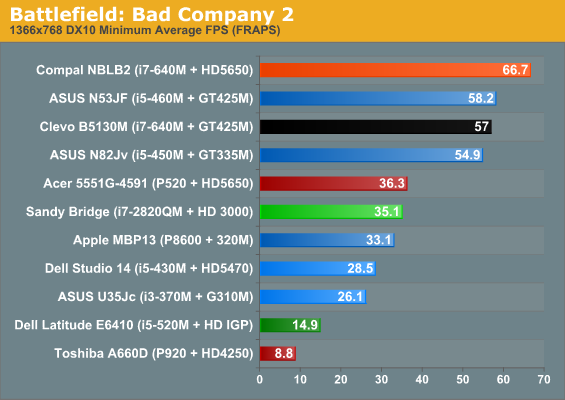
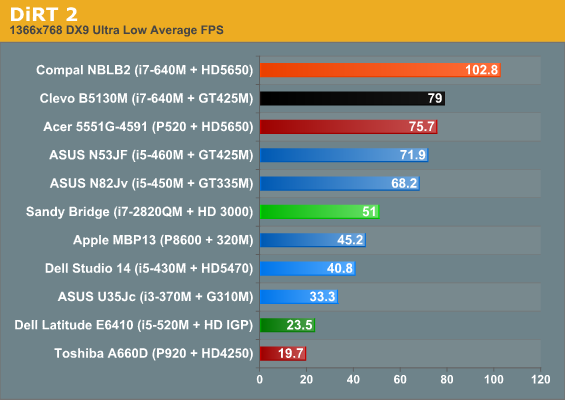
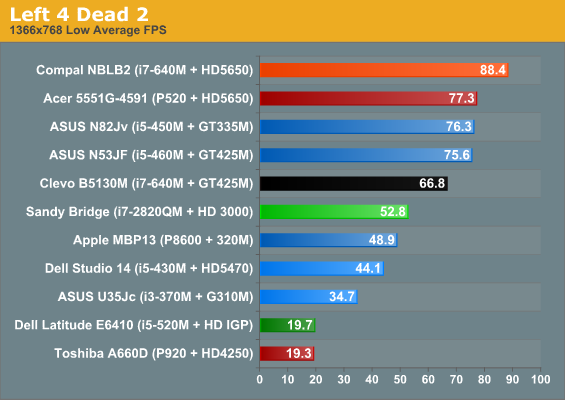
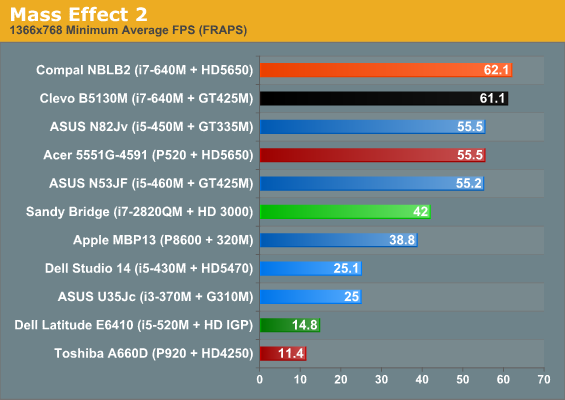
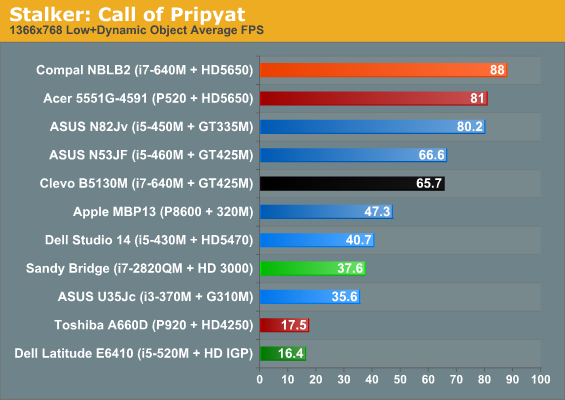
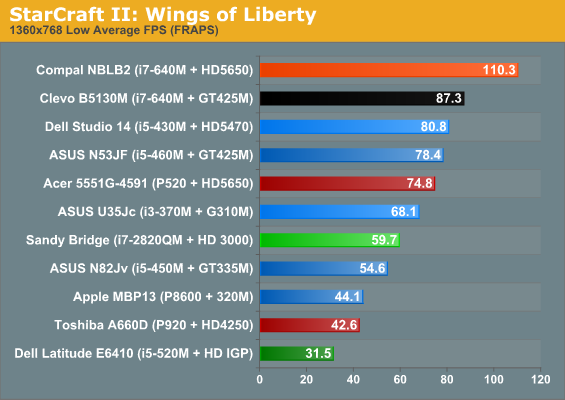

Let’s start by talking about compatibility problems with the Intel IGP: there were none! I know it’s been fashionable over the years to bash on Intel for horrible drivers that can’t run games, and the previous IGPs certainly still fall into that “too slow” category, but of our standard six test titles both Sandy Bridge and Arrandale IGPs loaded and ran every single title. That makes talk of performance meaningful, and that’s the bigger story by far.
Again, Sandy Bridge delivers playable performance in every single title at 768p and “Low” detail settings. What’s more, it actually surpasses the GeForce 320M in Apple’s MacBook Pro 13 in five out of six games (the exception being STALKER). Similarly, it beats the entry-level Radeon Mobility 5470 in four out of six games (STALKER and StarCraft II being the exceptions) and the G 310M in five out of six (SC2 came out ahead on the 310M).
All told, Intel’s HD Graphics 3000 checks in an average of 6% faster than HD 5470, 8% faster than GeForce 320M, 25% faster than G 310M, and a whopping 130% faster than both the previous generation HD Graphics and AMD’s HD 4250 (which are essentially tied in overall performance across the selected titles). Which is not to say it wins everywhere; even with a much slower Turion II P520 Processor, the HD 5650 still leads HD 3000 by 44%; shift the same GPU to an i7-640M to remove the CPU bottleneck and the 5650 beats HD 3000 by 130%. NVIDIA’s GeForce GT 425M also leads the 3000 by 46% on average, so discrete GPUs are by no means in danger of being replaced.
We didn't have time to do serious image quality comparisons, but subjectively there did appear to be a few games where the Intel IGP wasn't rendering at the same level of detail, but it's hard to say when you're not running at the native LCD resolution; we'll get into problems in a moment, but other than those mentioned we didn't have any serious complaints. After all, being able to run a game at all is the first consideration; making it look good is merely the icing on the cake.










66 Comments
View All Comments
seamusmc - Friday, January 7, 2011 - link
I'm a notebook noob, up till now I've avoided them as much as I could. I have evaluated them over the years and have a pretty good dell precision 4500 at work, however, I had to build a desktop because the laptop, as provided, just doesn't cut it. With a SSD and 8 GB of ram it would probably suffice but I run a lot of Virtual Machines for testing.Anyhoo, enough of my background: I am very interested in the Sandy Bridge line specifically the retail chips, 2720 and 2820.
However all I'm seeing announced from the OEM's are 2630 based solutions. Are the OEM's going to have an option to upgrade to the retail chips? Are the 2720 and 2820 going to be available any time soon or is it just the 2630 that will have broad availability?
Who will have the retail chips available?
GullLars - Saturday, January 8, 2011 - link
This review unit came with an Intel SSD, which probably made a huge impact on general usage, but can we expect SSD boot drives for most Sandy Bridge laptops?If i were Intel, i'd make a branding program where Sandy + Intel SSD (310, G2, or newer) gave a fancy sticker for marketers to drool over, guaranteeing smooth and snappy operation without hiccups from spinning platter IOs.
IntoGraphics - Monday, January 17, 2011 - link
"We might get some of the above in OEM systems sent for review, and if so it will be interesting to see how much of an impact the trimmed clock speeds have on overall performance."Looking forward for this to happen. Very important to know for me. Because I will be using Adobe Illustrator CS4, Cinema 4D R12 Prime, and Unity 3D.
I hope that the performance impact between an i7-2720QM and a i7-2820QM, is as minimal as it was between the i7-740QM and i7-840QM.
It's going to be a toss up between the SB Dell XPS 17 and the SB HP Envy 17 for me, combined with a Dell or HP 30" monitor. Just too bad that both notebooks will not offer 1920x1200 resolution.
psiboy - Wednesday, January 19, 2011 - link
Your gaming benchmark is a joke! Anyone who has a radeon 5650m in there laptop isn't going to set game setting to "Ultra Low" a good mid range setting would have been more realistic and probably playable... but the Intel HD graphics on Sandy Bridge would not have looked so good then.... "Lies, damned lies and statistics!" all manipulated so the uneducated are taken in to think they can game on Intel IGP's....BTW: Dirt 2 looks like crap on Ultra Low...
katleo123 - Tuesday, February 1, 2011 - link
It works on new motherboards based on Intel’s forthcoming 6-series chipsetsVisit http://www.techreign.com/2010/12/intels-sandy-brid...
welcomesorrow - Friday, June 10, 2011 - link
Hi,I would mostly appreciate your suggestions regarding the bottleneck of overclocked QSV.
I have Core i5-2400s on Intel's DH67BL (H67) mother and have been using Media Espresso 6.5 to transcode ts files (MPEG-2) into H.264 by QSV. DH67BL allows me to overclock the graphics core from its default 1.1GHz to 2GHz. I observe linear shortening of transcoding time from 43 seconds/GB (1.1GHz) to 35 seconds/GB (1.6GHz), but beyond that there is no further improvement. Thus, it is expected to be transcoding in 30 seconds/GB at 2GHz but in reality it takes 35 seconds/GB.
QSV encoding in Media Espresso 6.5 is already ultrafast, and first I thought it might be hitting the I/O bandwidth of HDD, but it was not the case because SSD or even RAMDISK did not improve the situation.
Any idea about what is becoming the bottleneck of overclocked QSV? My guess is that it has something to do with either Sandy Bridge's internal hardware (such as data transfer) or Media Espresso's logic or both.